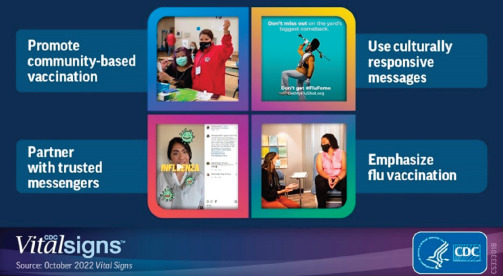Brooke Whittington, PharmD
CDC estimates that the United States will experience a high influenza disease burden for the 2022–2023 season. CDC surveillance data from late October 2022 show that there have been more than 880,000 flu infections nationwide so far this season, including 6,900 hospitalizations and 360 deaths, making for an unusually early and brutal cycle.
Pharmacists are in a unique position to screen and identify patients in need of their flu vaccine and increase immunization rates within their community. Here's what pharmacists should know about the flu vaccination this season.

Is it safe to coadminister the COVID-19 and flu vaccines?
Yes, it is safe to administer both vaccines in the same visit if it is indicated. A CDC study published in 2022 found that patients who received both the flu and COVID-19 vaccines were somewhat more likely (8%–11%) to experience reactions such as fatigue, headache, and muscle ache, but concluded that it did not pose significant safety concerns.
Additionally, a retrospective cohort analysis completed in 2021 by the University of Miami Miller School of Medicine found patients with COVID-19 that received their flu vaccine were significantly less likely to visit the emergency department and be admitted to the ICU.
How can I stay up to date on infection rates?
Flu rates are projected to increase in frequency and severity this season compared to last year. A National Foundation for Infectious Diseases survey released in October 2022 found that only 49% of adults in the United States plan to receive their flu vaccine.
CDC provides a weekly flu surveillance report (FLUView) that is available online. Pharmacists should also check their local public health department agency's website for more information.
Are there inequities in flu vaccination rates among different groups? How can pharmacists address these health disparities?
CDC has found that Black, Hispanic, and American Indian/Alaska Native individuals have low vaccination rates and are more likely to be hospitalized with the flu. Patients who experience health inequities are also more likely to be diagnosed with comorbidities such as diabetes, asthma, and other health conditions. The flu may exacerbate or worsen these conditions, leading to poor health outcomes. Pharmacists can advocate for these vaccines within these communities through motivational interviewing and cultural sensitivity.
What is motivational interviewing and how can it be incorporated into everyday practice?
Misinformation continues to spread rampantly, and pharmacists are essential at countering vaccine hesitancy.
Motivational interviewing is a technique health care providers can use to build confidence and trust with patients.
This can include the pharmacist actively listening, acknowledging the patient's concerns, and then asking permission to give advice. This method serves as a discussion versus a lecture, according to CDC.
What practice and education resources does APhA provide for more information about immunizations?
APhA offers a wide multitude of immunization resources and education that includes reference guides, vaccine technique, and technician integration in pharmacy immunization services training, and much more.
Check out APhA's Immunization Center on pharmacist.com for the latest information.